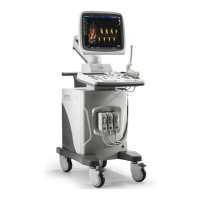SSI-6000/SSI-5800/SSI-5500/SSI-5500BW
Digital Color Doppler Ultrasound System
4. Select a low setting for each new patient. Output should only be increased
during the examination if penetration is still required to achieve a satisfactory
result, and after the Gain control has been moved to its maximum value.
5. Maintain the shortest examination time necessary to produce a useful diag-
nostic result.
6. Do not hold the probe in a fixed position for any longer than is necessary. It
should be removed from the patient whenever there is no need for real-time
imaging or spectral Doppler acquisition. The freeze frame and Cine loop
capabilities allow images to be reviewed and discussed without exposing
the patient to continuous scanning.
7. Do not use endo-cavity probes if there is noticeable self heating of the probe
when operating in the air. Although applicable to any probe, take particular
care during trans-vaginal exams during the first eight weeks of gestation.
8. Take particular care to reduce output and minimize exposure time of an em-
bryo or fetus when the temperature of the mother is already elevated.
9. Take particular care to reduce the risk of thermal hazard during diagnostic
ultrasound when exposing: an embryo less than eight weeks after gestation;
or the head, brain or spine of any fetus or neonate.
10. Operators should continually monitor the on-screen thermal index (TI) and
mechanical index (MI) values and use control settings that keep these set-
tings as low as possible while still achieving diagnostically useful results.
In obstetric examinations, TIS (soft tissue thermal index) should be moni-
tored during scans carried out in the first eight weeks after gestation, and
TIB (bone thermal index) thereafter. In applications where the probe is very
close to bone (e.g. trans-cranial applications), TIC (cranial thermal index)
should be monitored.
MI> 0.3 There is a possibility of minor damage to
neonatal lung or intestine. If such expo-
sure is necessary, reduce the exposure
time as much as possible.
MI> 0.7 There is a risk of cavitation if an ul-
trasound contrast agent containing gas
micro-spheres is being used. There is
a theoretical risk of cavitation without the
presence of ultrasound contrast agents.
The risk increases with MI values above
this threshold.
TI> 0.7 The overall exposure time of an embryo
or fetus should be restricted in accor-
dance with Table 1.1 below as a refer-
ence.
P/N: 4701-0061-01B
1-5

